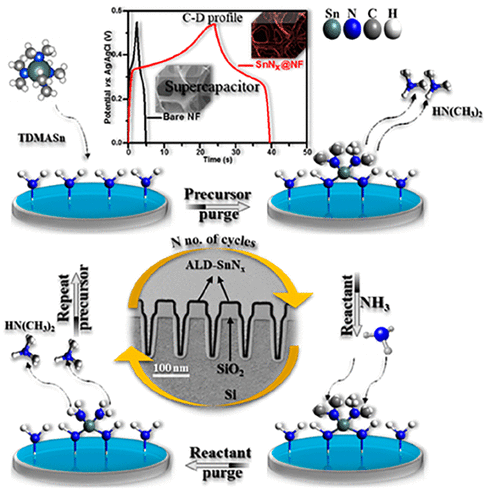当前位置:
X-MOL 学术
›
ACS Appl. Mater. Interfaces
›
论文详情
Our official English website, www.x-mol.net, welcomes your
feedback! (Note: you will need to create a separate account there.)
Low-Temperature Atomic Layer Deposition of Highly Conformal Tin Nitride Thin Films for Energy Storage Devices
ACS Applied Materials & Interfaces ( IF 8.3 ) Pub Date : 2019-11-05 , DOI: 10.1021/acsami.9b15790 Mohd Zahid Ansari 1 , Dip K. Nandi 1 , Petr Janicek 2, 3 , Sajid Ali Ansari 4 , Rahul Ramesh 1 , Taehoon Cheon 1, 5 , Bonggeun Shong 6 , Soo-Hyun Kim 1
ACS Applied Materials & Interfaces ( IF 8.3 ) Pub Date : 2019-11-05 , DOI: 10.1021/acsami.9b15790 Mohd Zahid Ansari 1 , Dip K. Nandi 1 , Petr Janicek 2, 3 , Sajid Ali Ansari 4 , Rahul Ramesh 1 , Taehoon Cheon 1, 5 , Bonggeun Shong 6 , Soo-Hyun Kim 1
Affiliation

|
We present an atomic layer deposition (ALD) process for the synthesis of tin nitride (SnNx) thin films using tetrakis(dimethylamino) tin (TDMASn, Sn(NMe2)4) and ammonia (NH3) as the precursors at low deposition temperatures (70–200 °C). This newly developed ALD scheme exhibits ideal ALD features such as self-limited film growth at 150 °C. The growth per cycle (GPC) was found to be ∼0.21 nm/cycle at 70 °C, which decreased with increasing deposition temperature. Interestingly, when the deposition temperature was between 125 and 180 °C, the GPC remained almost constant at ∼0.10 nm/cycle, which suggests an ALD temperature window, whereas upon further increasing the temperature to 200 °C, the GPC considerably decreased to ∼0.04 nm/cycle. Thermodynamic analysis via density functional theory calculations showed that the self-saturation of TDMASn would occur on an NH2-terminated surface. Moreover, it also suggests that the condensation of a molecular precursor and the desorption of surface *NH2 moieties would occur at lower and higher temperatures outside the ALD window, respectively. Thanks to the characteristics of ALD, this process could be used to conformally and uniformly deposit SnNx onto an ultranarrow dual-trench Si structure (minimum width: 15 nm; aspect ratio: ∼6.3) with ∼100% step coverage. Several analysis tools such as transmission electron microscopy, X-ray diffraction (XRD), X-ray photoelectron spectroscopy, Rutherford backscattering spectrometry, and secondary-ion mass spectrometry were used to characterize the film properties under different deposition conditions. XRD showed that a hexagonal SnN phase was obtained at a relatively low deposition temperature (100–150 °C), whereas cubic Sn3N4 was formed at a higher deposition temperature (175–200 °C). The stoichiometry of these thermally grown ALD-SnNx films (Sn-to-N ratio) deposited at 150 °C was determined to be ∼1:0.93 with negligible impurities. The optoelectronic properties of the SnNx films, such as the band gap, wavelength-dependent refractive index, extinction coefficient, carrier concentration, and mobility, were further evaluated via spectroscopic ellipsometry analysis. Finally, ALD-SnNx-coated Ni-foam (NF) and hollow carbon nanofibers were successfully used as free-standing electrodes in electrochemical supercapacitors and in Li-ion batteries, which showed a higher charge-storage time (about eight times greater than that of the uncoated NF) and a specific capacity of ∼520 mAh/g after 100 cycles at 0.1 A/g, respectively. This enhanced performance might be due to the uniform coverage of these substrates by ALD-SnNx, which ensures good electric contact and mechanical stability during electrochemical reactions.
中文翻译:

用于能量存储设备的高度共形氮化锡薄膜的低温原子层沉积
我们提出了使用四(二甲基氨基)锡(TDMASn,Sn(NMe 2)4)和氨气(NH 3)合成氮化锡(SnN x)薄膜的原子层沉积(ALD)工艺)作为低沉积温度(70–200°C)的前体。这种新开发的ALD方案具有理想的ALD功能,例如在150°C时具有自限膜生长能力。发现在70°C时,每循环的生长量(GPC)为〜0.21 nm /循环,随着沉积温度的升高而降低。有趣的是,当沉积温度在125至180°C之间时,GPC几乎保持恒定在〜0.10 nm /周期,这表明了ALD温度窗口,而当温度进一步升高至200°C时,GPC则显着下降至〜 0.04 nm /周期 通过密度泛函理论计算的热力学分析表明,在NH 2上会发生TDMASn的自饱和-终止的表面。此外,这也表明分子前体的缩合和表面* NH 2部分的解吸将分别在ALD窗外的较低和较高温度下发生。由于ALD的特性,该工艺可用于共形和均匀地沉积SnN x在约100%台阶覆盖率的超窄双沟槽Si结构上(最小宽度:15 nm;纵横比:〜6.3)。几种分析工具,例如透射电子显微镜,X射线衍射(XRD),X射线光电子能谱,卢瑟福背散射光谱法和二次离子质谱法被用来表征在不同沉积条件下的薄膜性能。XRD显示,在较低的沉积温度(100-150°C)下获得了六方晶的SnN相,而在较高的沉积温度(175-200°C)下形成了立方Sn 3 N 4。这些热生长的ALD-SnN x的化学计量经测定,在150°C沉积的薄膜(Sn与N的比)约为1:0.93,且杂质可以忽略不计。SnN x薄膜的光电性能,如带隙,与波长有关的折射率,消光系数,载流子浓度和迁移率,通过光谱椭偏分析进一步评估。最后,ALD-SnN x包覆的镍泡沫(NF)和中空碳纳米纤维已成功地用作电化学超级电容器和锂离子电池中的自立式电极,具有更长的电荷存储时间(约为电池的八倍)。 100次循环后在0.1 A / g下的比容量约为520 mAh / g。这种增强的性能可能是由于ALD-SnN对这些基板的均匀覆盖x,确保电化学反应期间良好的电接触和机械稳定性。
更新日期:2019-11-05
中文翻译:

用于能量存储设备的高度共形氮化锡薄膜的低温原子层沉积
我们提出了使用四(二甲基氨基)锡(TDMASn,Sn(NMe 2)4)和氨气(NH 3)合成氮化锡(SnN x)薄膜的原子层沉积(ALD)工艺)作为低沉积温度(70–200°C)的前体。这种新开发的ALD方案具有理想的ALD功能,例如在150°C时具有自限膜生长能力。发现在70°C时,每循环的生长量(GPC)为〜0.21 nm /循环,随着沉积温度的升高而降低。有趣的是,当沉积温度在125至180°C之间时,GPC几乎保持恒定在〜0.10 nm /周期,这表明了ALD温度窗口,而当温度进一步升高至200°C时,GPC则显着下降至〜 0.04 nm /周期 通过密度泛函理论计算的热力学分析表明,在NH 2上会发生TDMASn的自饱和-终止的表面。此外,这也表明分子前体的缩合和表面* NH 2部分的解吸将分别在ALD窗外的较低和较高温度下发生。由于ALD的特性,该工艺可用于共形和均匀地沉积SnN x在约100%台阶覆盖率的超窄双沟槽Si结构上(最小宽度:15 nm;纵横比:〜6.3)。几种分析工具,例如透射电子显微镜,X射线衍射(XRD),X射线光电子能谱,卢瑟福背散射光谱法和二次离子质谱法被用来表征在不同沉积条件下的薄膜性能。XRD显示,在较低的沉积温度(100-150°C)下获得了六方晶的SnN相,而在较高的沉积温度(175-200°C)下形成了立方Sn 3 N 4。这些热生长的ALD-SnN x的化学计量经测定,在150°C沉积的薄膜(Sn与N的比)约为1:0.93,且杂质可以忽略不计。SnN x薄膜的光电性能,如带隙,与波长有关的折射率,消光系数,载流子浓度和迁移率,通过光谱椭偏分析进一步评估。最后,ALD-SnN x包覆的镍泡沫(NF)和中空碳纳米纤维已成功地用作电化学超级电容器和锂离子电池中的自立式电极,具有更长的电荷存储时间(约为电池的八倍)。 100次循环后在0.1 A / g下的比容量约为520 mAh / g。这种增强的性能可能是由于ALD-SnN对这些基板的均匀覆盖x,确保电化学反应期间良好的电接触和机械稳定性。































 京公网安备 11010802027423号
京公网安备 11010802027423号